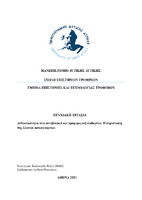| dc.contributor.advisor | Batrinou, Anthimia | |
| dc.contributor.author | Κουλουρίδη, Ελένη | |
| dc.date.accessioned | 2021-07-28T07:43:51Z | |
| dc.date.available | 2021-07-28T07:43:51Z | |
| dc.date.issued | 2021-07 | |
| dc.identifier.uri | https://polynoe.lib.uniwa.gr/xmlui/handle/11400/985 | |
| dc.identifier.uri | http://dx.doi.org/10.26265/polynoe-836 | |
| dc.description.abstract | Οι Τροφιμογενείς παθογόνοι μικροοργανισμοί αποτελούν μεγάλο πρόβλημα για τη
βιομηχανία τροφίμων καθως μπορουν να προκαλέσουν ασθένειες ακόμα και το θάνατο σε
μεγάλα μέρη του πληθυσμου, κυρίως στις ευπαθείς ομάδες. Η ανθεκτικότητα στα
αντιβιοτικά είναι ένα φαινόμενο που εξελίσσεται ραγδαία και συμβάλλει στην
επικινδυνότητα μιας τροφιμογενούς μόλυνσης. Στην παρούσα εργασία θα παρουσιαστούν οι
βασικές ομάδες αντιβιοτικών και μερικοί από τους τρόπους δράσης τους. Επίσης οι τρόποι με
τους οποίους οι μικροοργανισμοί αντιστέκονται στα αντιβιοτικά. Θα αναλυθούν κάποια από
τα κυριότερα τροφιμογενή παθογόνα, τα χαρακτηριστικά τους, οι πιθανές πηγές επιμόλυνσης
από αυτά και πως συνδέονται με επιδημίες. Η Listeria monocytogenes είναι ένα ψυχρότροφο
βακτήριο που προκαλεί τη λιστερίωση, μια σπάνια, αλλά μεγάλης θνησιμότητας ασθένεια.
Μπορεί να αναπτυχθεί στα προϊόντα που συντηρούνται υπό ψύξη και στα έτοιμα προς
κατανάλωση τρόφιμα. Ο σύγχρονος τρόπος ζωής καθιστά δημοφιλή αυτά τα προϊόντα
αυξάνοντας την πιθανότητα επιμόλυνσης με L.monocytogenes. Θα αναλυθούν οι πηγές
επιμόλυνσης, η παθογένεια του μικροοργανισμού, οι τρόποι ανίχνευσης, αλλά και διάκρισης
του από άλλα μη παθογόνα στελέχη και τα γενετικά στοιχεία που συμβάλλουν στην
ανθεκτικότητα του στα αντιβιοτικά. Τέλος, θα γίνει μια αναφορά, για τον τρόπο που
προσεγγίζουν το πρόβλημα της χρήσης των αντιβιοτικών, ως αυξητικούς παράγοντες στη
βιομηχανία κρέατος, στην Ευρωπαϊκή Ένωση και στις ΗΠΑ. | el |
| dc.format.extent | 83 | el |
| dc.language.iso | el | el |
| dc.publisher | Πανεπιστήμιο Δυτικής Αττικής | el |
| dc.rights | Αναφορά Δημιουργού - Μη Εμπορική Χρήση - Παρόμοια Διανομή 4.0 Διεθνές | * |
| dc.rights.uri | https://creativecommons.org/licenses/by-nc-sa/4.0/deed.el | * |
| dc.subject | Τροφιμογενές | el |
| dc.subject | Παθογόνα | el |
| dc.subject | Ανθεκτικότητα | el |
| dc.subject | Αντιβιοτικά | el |
| dc.subject | Listeria monocytogenes | el |
| dc.title | Ανθεκτικότητα στα αντιβιοτικά και τροφιμογενή παθογόνα: Η περίπτωση της Listeria monocytogenes | el |
| dc.title.alternative | Foodborne pathogens and antibiotic resistance: The case of Listeria monocytogenes | el |
| dc.type | Πτυχιακή εργασία | el |
| dc.contributor.committee | Σπηλιώτης, Βασίλης | |
| dc.contributor.committee | Μάντης, Φώτιος | |
| dc.contributor.faculty | Σχολή Επιστημών Τροφίμων | el |
| dc.contributor.department | Τμήμα Επιστήμης και Τεχνολογίας Τροφίμων | el |
| dc.description.abstracttranslated | Foodborne pathogens, account for a big problem for the food industry, which can lead to
severe illnesses and even death to a big part of the population. Antibiotic resistance is
progressively evolving and makes foodborne illnesses even more dangerous. In this essay, the
basic classes of antibiotics and their mechanisms of action will be presented. Also, the
mechanisms in which, bacteria resist to antibiotics. Some of the most important foodborne
pathogens, will be analysed and also their characteristics, the possible sources of
contamination and some outbreaks in which they are involved. Listeria monocytogenes, is a
psychrotrophic bacterium, that causes listeriosis, a rare but severe illness, with a high
mortality rate. Its prevalence is very often in products that require refrigeration, and in Ready
To Eat products. The modern way of living makes these products very popular and makes the
possibility of contamination with L.monocytogenes, very possible. The sources of
contamination will be also analyzed, the pathogenesis of the microorganism, some detection
methods and the genetic elements that contribute to its antibiotic resistance. In the end of this
essay, some comments will be mentioned, of how European Union and United States of
America are dealing, with the problem of antibiotic misuse in the meat industry. | el |


